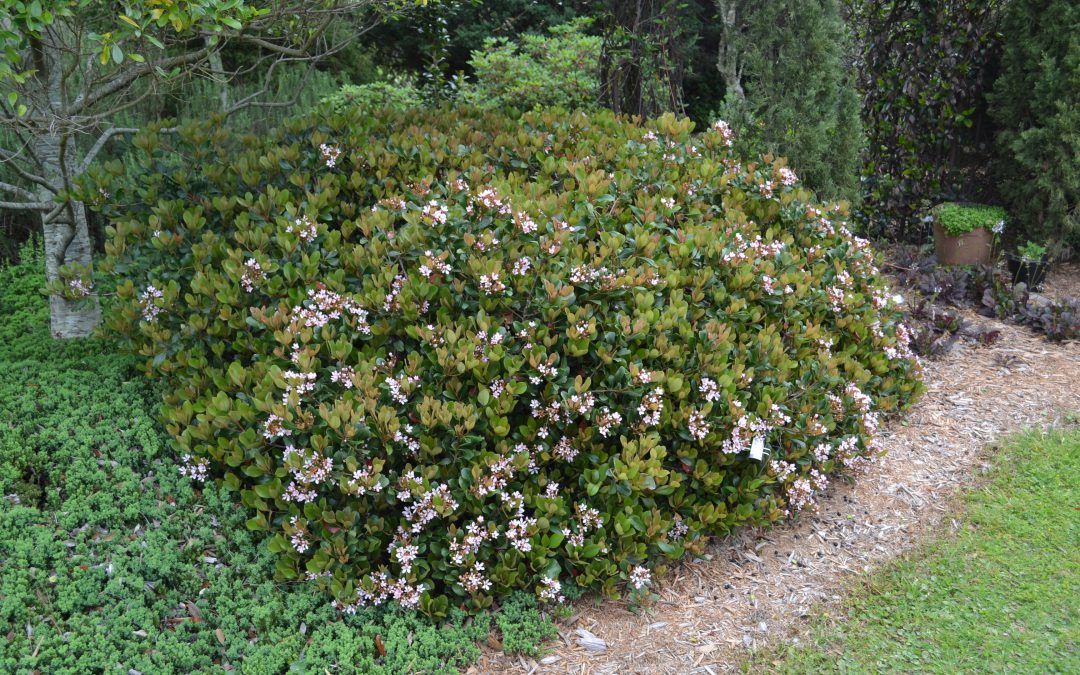
by Carrie Stevenson | Aug 1, 2019
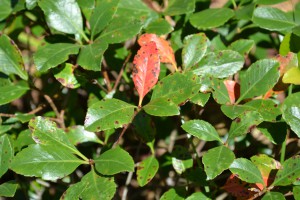
Reddish, round spots are the first sign of Entomosporium Leaf Spot on Indian Hawthorn. Photo credit: Beth Bolles, UF IFAS Extension
Indian hawthorn (Rhaphiolepis spp.) is one of those great evergreen shrubs with such a reputation for hardiness that most folks tend to plant it and not worry about it. Indian hawthorn is not a Florida native, but is adapted to our weather conditions and is widely used in home landscapes throughout the Southeast.
However, it is important that homeowners and landscape managers pay attention to them, particularly during the warm, often wet weather growing season. During such conditions, the plant is vulnerable to Indian hawthorn leaf spot, caused by a fungus called Entomosporium mespili. Several years back, this fungus spread through the once-popular red-tip plant (Photinia fraser), to the extent that this species is now rarely used.
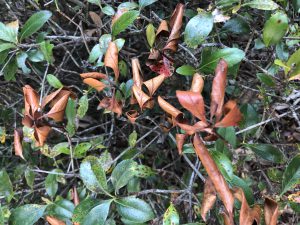
An Indian hawthorn plant heavily affected with leaf spot fungus can be covered with round circles on the green leaves, eventually leading to plant death. Photo credit: Carrie Stevenson, UF IFAS Extension
Symptoms of leaf spot fungi include small, circular red spots on young leaves, which then expand into larger patches. On older leaves, the spots are gray in the middle with red/maroon borders. Eventually, leaves can drop and entire plants may defoliate and die. The disease typically spreads through rainwater or overhead irrigation.
To manage the disease, it is best to create space between a sick plant and a healthy one to allow better air circulation. This will allow leaves to dry off after rainfall events and prevent expansion of spores. Be sure not to overwater, prune, or fertilize shrubs that show signs of the disease, as this encourages growth—the fungus thrives particularly well on young, vigorously growing leaves.
For leaf spot problems that become difficult to manage with just cultural practices, fungicides containing chlorothalonil, myclobutanil, or propiconazole may be used. Always follow label instructions when using chemical management and apply in the spring or fall. In addition, dead or dying plants should be removed and replaced with cultivars showing resistance to Entomosporium leaf spot, including Eleanor Tabor, Indian Princess, Gulf Green, Betsy, Blueberry Muffin, Georgia Petite, Olivia, and Snow White.
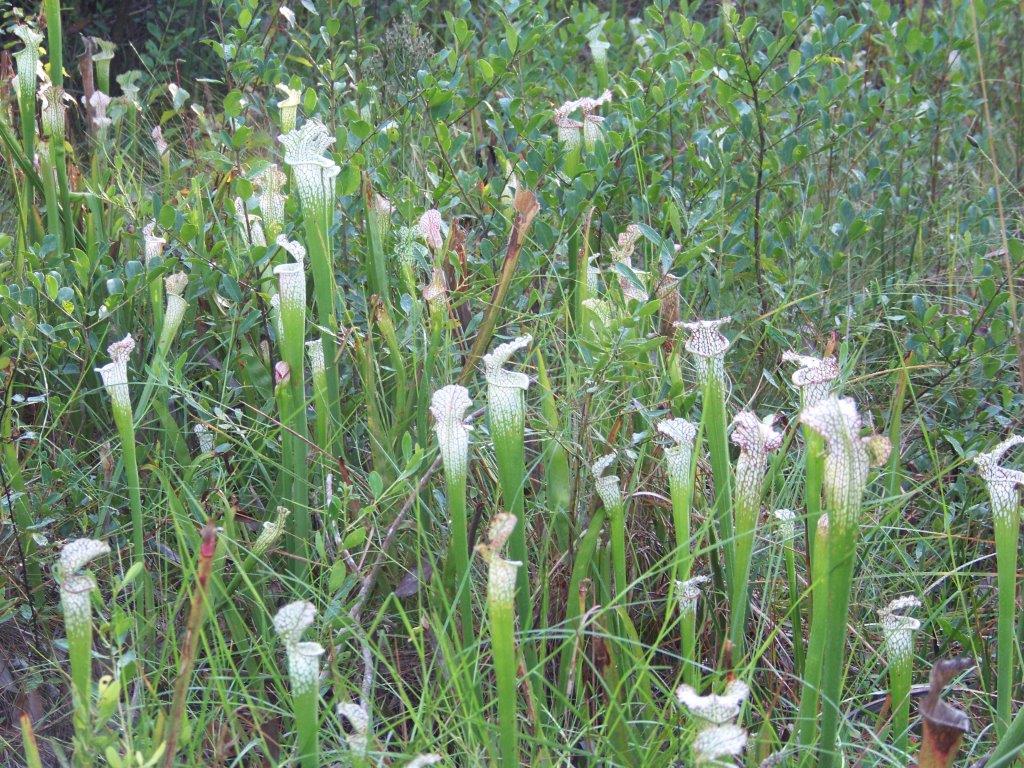
by Carrie Stevenson | Jun 19, 2019
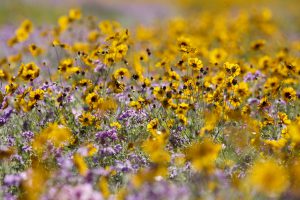
Wildflowers near Live Oak, Florida. Image Credit, UF / IFAS
Florida (“land of flowers” in Spanish) is and has always been full of flowers, and countless civic and public organizations work diligently to protect and promote the beauty of our natural ecosystems. Did you know that the Florida Wildflower Foundation works with the Florida Department of Transportation (FDOT) to preserve wildflower areas on state-maintained roads throughout Florida? This effort really took off in the 1960’s when non-native Crimson clover started sprouting among sod planted by the state FDOT, and has grown into a much larger statewide initiative. The state wildflower license plate program provides funding for these efforts.
Wildflower areas along highways not only improve beauty on the roadsides, but provide habitat for countless pollinator insects that drive our $1.2 billion (annual) citrus and agricultural industries and our own backyard landscapes. In addition, leaving no-mow areas along highways saves money on mowing costs, reduces soil erosion, and improves air quality.
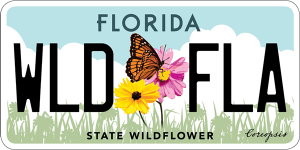
The state wildflower license plate supports wildflower preservation efforts statewide. Photo credit: Florida Wildflower Foundation
Wildflower viewing is typically best in the spring and fall, and particularly in areas (such as state parks and forests) that have been recently managed by prescribed fire. Many low-lying areas are home to beautiful native species such as pitcher plants, hibiscus, and meadowbeauty. Be very careful when viewing or stopping to see roadside wildflowers, and be sure to find designated parking areas to prevent accidents. To find a map of the wildflower trails, visit your local tourism bureau or go online at https://flawildflowers.org/protect/.
Currently, every Panhandle county from Jefferson County east has designated wildflower areas. The Escambia County Board of Commissioners passed a wildflower ordinance supporting the program, and a committee met in May 2019 to determine more areas of the county appropriate to set aside for the program. As opposed to planting new wildflowers, the program prioritizes conserving roadside areas that already support healthy wildflower populations. If you know of good candidates for preservation on state roads in Escambia or any other panhandle county, please contact me (ctsteven@ufl.edu) or Liz Sparks (liz.aparks57@gmail.com) with the Florida Wildflower Foundation.
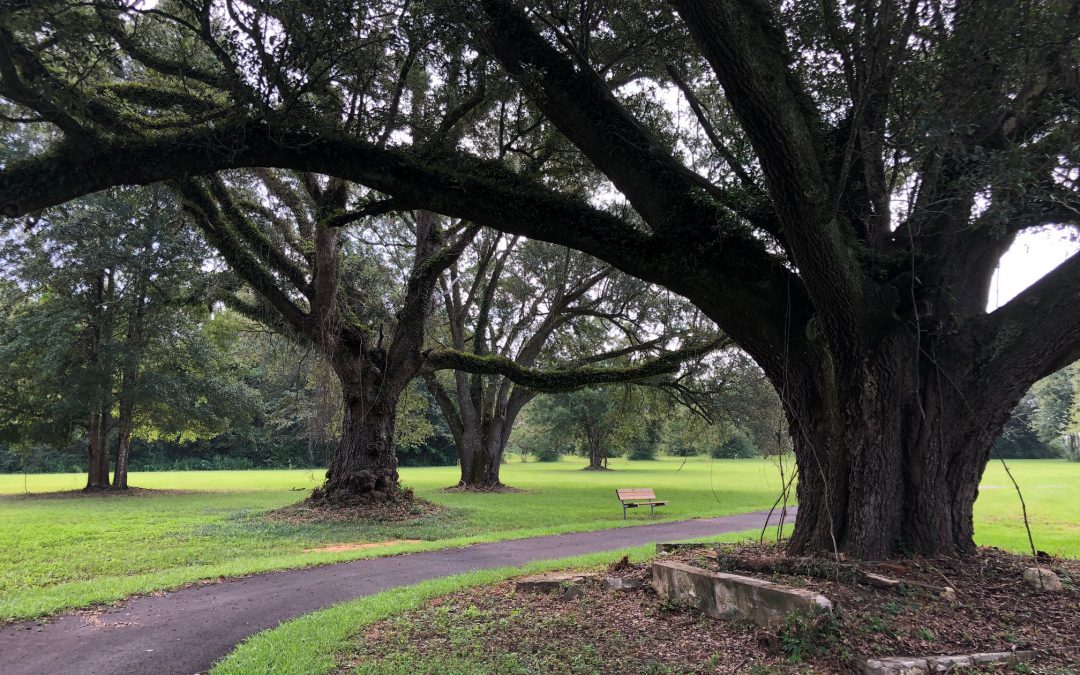
by Carrie Stevenson | Apr 16, 2019
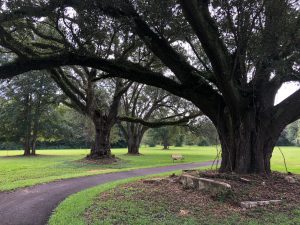
Historic live oaks provide shade and wildlife habitat at the Escambia Extension walking trail. Photo credit: Carrie Stevenson, UF / IFAS Extension
A recent study of 3-5 year olds found that the average pre-reading American child could identify hundreds of marketing brand logos (McDonald’s, Disney, even Toyota). Most researchers would be mightily challenged to find even a middle school student who can identify more than a couple of trees growing in their own backyard. The fields and forests many of us grew up in are steadily converting to look-alike suburban areas, so this lack of local natural knowledge is commonplace. As the quote by Senegalese forester Baba Dioum goes, “In the end, we will conserve only what we love; we will love only what we understand and we will understand only what we are taught.” If kids and adults do not appreciate and understand the natural world around them, we are unlikely to preserve these priceless wonders.
To do our part towards this aim of educating others, we at Escambia Extension received a grant from International Paper to plant 30 trees around our office’s walking track. Every tree has a clearly marked identification tag listing its common and botanical name.
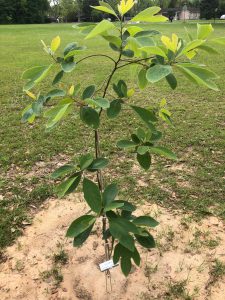
A newly planted sassafras tree on the Extension walking trail. Photo credit: Carrie Stevenson, UF / IFAS Extension
Initially we just planned to add more shade trees to the sunny side of the track, but after a discussion with local foresters, we realized this effort could be an ideal teaching tool. The local middle and high school Future Farmers of America (FFA) chapters participate in a tree identification contest, and are tasked with knowing 50 native tree species. While 10 of them were tropical species that do not perform well in north Florida, we have the other 40 planted here on the property. Students and any interested citizen interested in learning these native species can walk along our track, getting exercise and taking in the natural world around them.
A spring walking event will kick off the official opening of the tree identification trail, so join us April 26 to learn more about healthy living and the value of trees. Or, join us for an Extension Open House on April 27 to explore the demonstration gardens, purchase vegetable plants, or learn more about Extension’s wide array of community services.
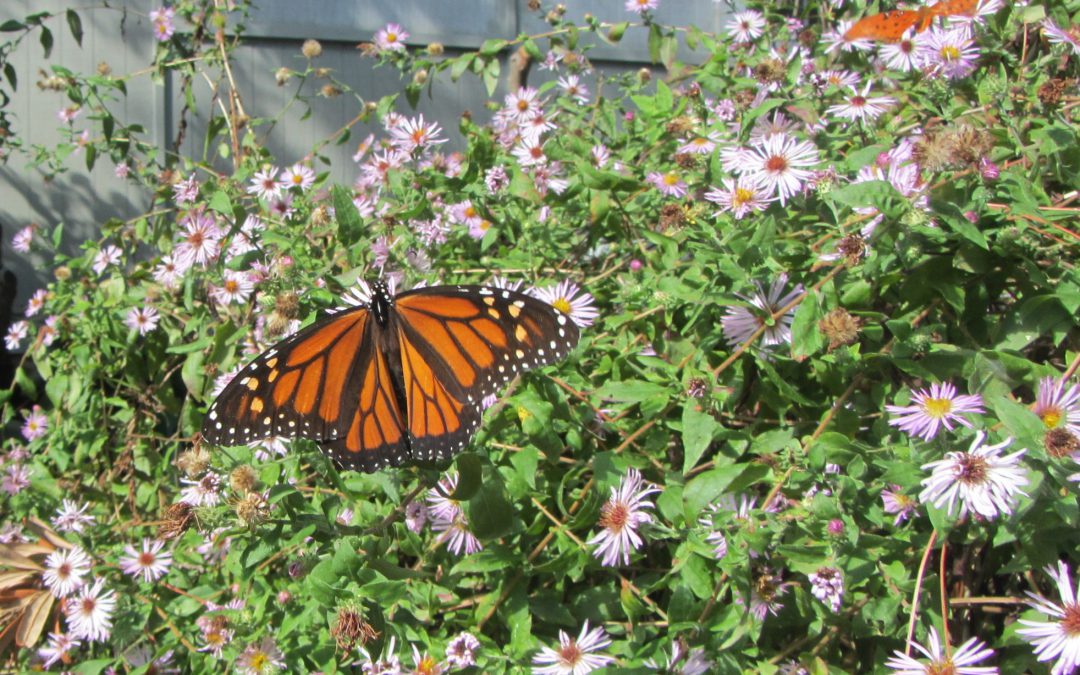
by Carrie Stevenson | Mar 26, 2019
One of the incredible benefits of living in Florida is exposure to the biodiversity of our wildlife population. From ordinary squirrels and mockingbirds to the more exotic panthers and migratory tropical birds, it is rare one can step outside the house without seeing or hearing wildlife of some variety. One of the practices we “preach” here at Extension is to provide habitat for wildlife in our yards and gardens. While cities and neighborhoods are human-centric, we share these spaces with thousands of wild animals, birds, fish, and insects and should always consider them in our actions.
Attracting birds and butterflies are popular pastimes, and Extension faculty can provide a tremendous amount of information on their preferences and food sources. However, a few unsung critters deserve homes and space as well. Just yesterday, I took a call from a gentleman who was excited to discover a small colony of bats roosting in a tree on his property. He was looking for ways to encourage them to stay, because he realized the countless benefits they provide in free insect control. Many people are nervous around bats of because of their unpredictable, irregular night flight pattern and association with scary stories. However, an average Florida bat can eat 1,000 insects a night, keeping pest populations down, reducing mosquito-borne disease, and saving millions of dollars in crop damage.
In our demonstration garden today, I was delighted to walk up on a black racer sunning itself in the grass. These common garden snakes provide valuable pest control of rats and mice, and are not aggressive or venomous. The fear of snakes often comes from the surprise of finding one unexpectedly, so always be alert and observant when outdoors. Respect for these creatures and a basic working knowledge of common venomous and nonvenomous species can go a long way towards calming one’s nerves. An excellent resource for snake identification in north Florida is this online guide. Like many snakes, this particular snake had been in tall grass, so it is always wise to be cautious in those areas.
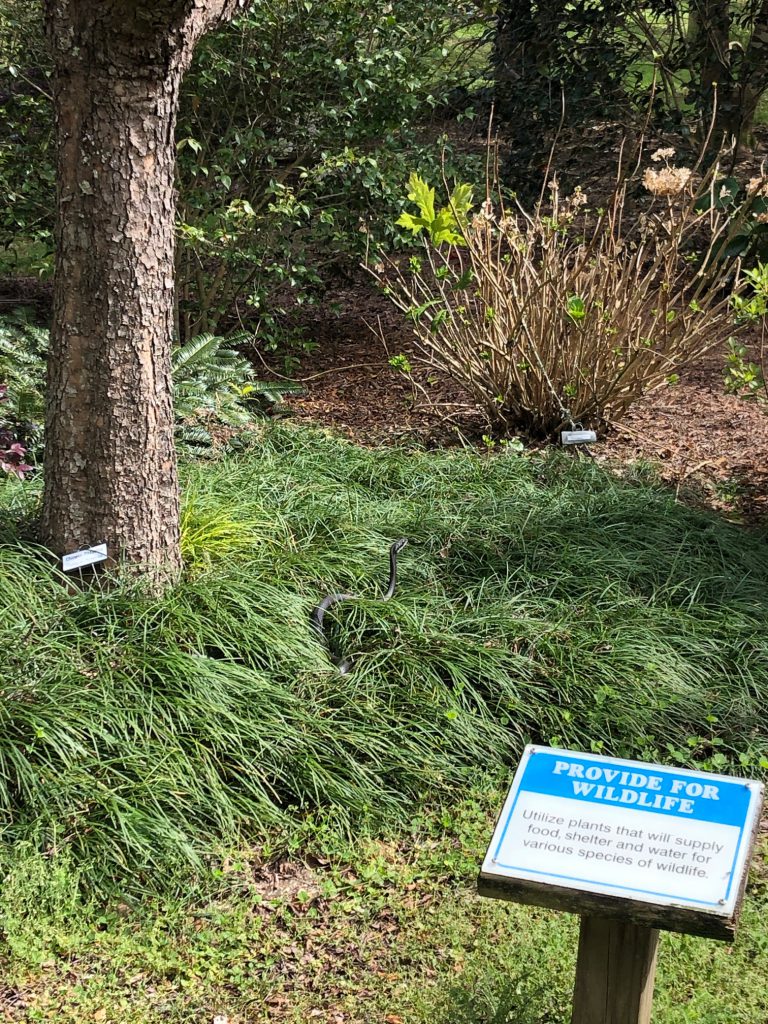
This black racer sunning in the grass must have gotten the message about utilizing habitat provided for wildlife! Photo credit: Carrie Stevenson, UF IFAS Extension
To attract wildlife, learn about their life cycle and food sources, and provide shelter, water, and food for the species you are interested in attracting. Keep in mind that inviting wildlife may also draw their predators, but know that this is part of the larger cycle. Always keep safety in mind, and if necessary keep tall vegetation and deep water to a minimum in play areas frequented by young children. The benefits of providing food and shelter for wildlife are countless for human observers and wildlife alike.
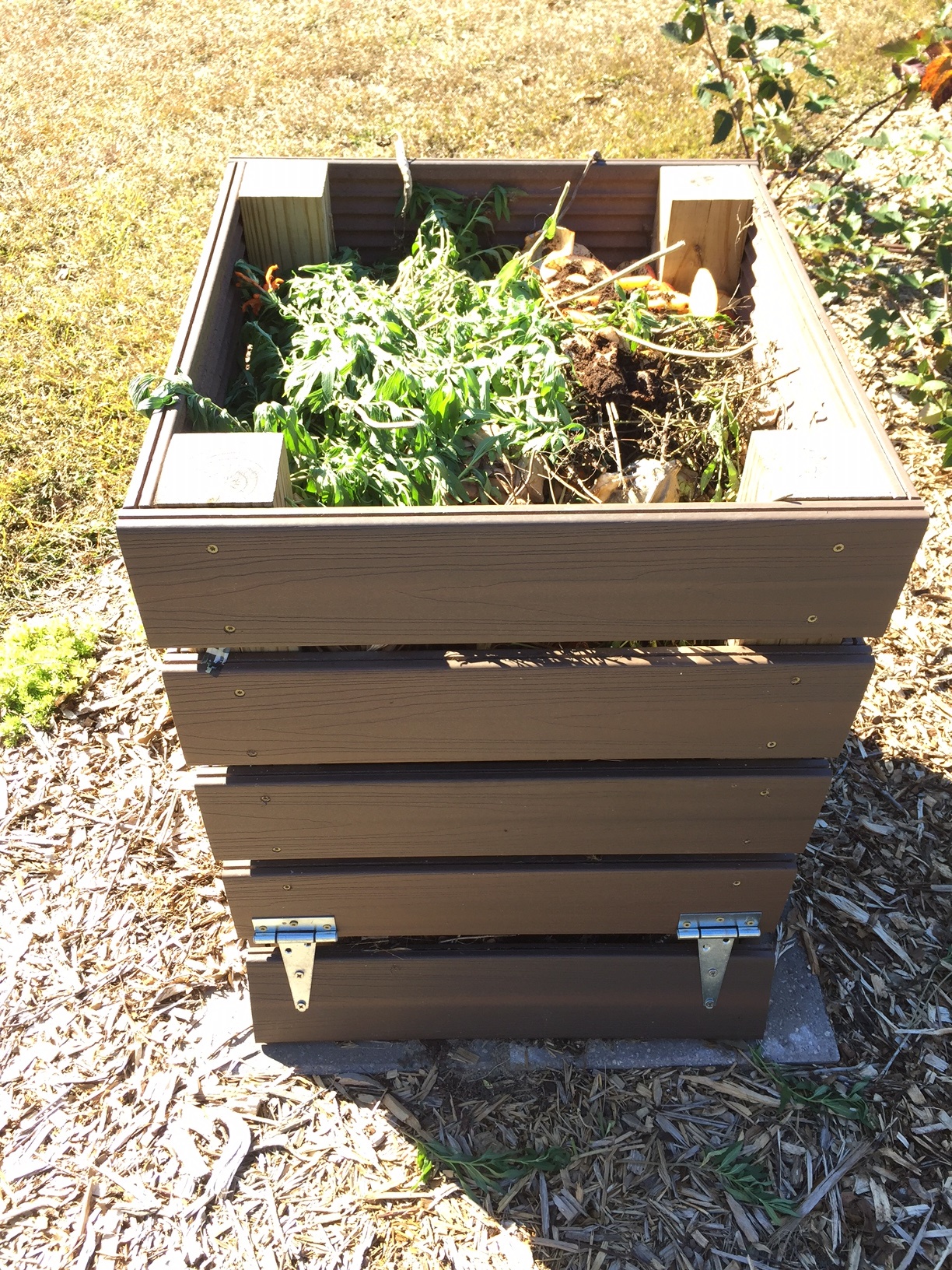
by Carrie Stevenson | Feb 26, 2019
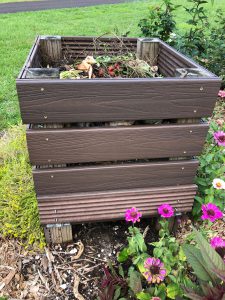
Compost bins can be built or purchased and provide an easy means of recycling food and yard waste into valuable soil for a garden. Photo credit: Carrie Stevenson, UF/ IFAS Extension
What better New Year’s resolution could there be than to start recycling and do our part to preserve our natural resources? By composting yard and kitchen waste, we can also get a jump-start on our spring gardening by creating your own mulch and fertilizer. Done properly, raw compost material can transform into nutrient-rich soil in just six weeks! A free source of “slow release” nutrients, compost also loosens tight, compacted soils and helps our often-sandy soils hold nutrients.
So what is compost? Essentially, it is what’s left of organic matter after it’s been thoroughly decomposed by microbes. Among the common compostable organic materials are leaves, grass clippings, twigs, pine straw, and vegetable/fruit peelings and coffee grounds. When using these items, alternate by using brown (leaves, straw) and green materials (grass clippings, vegetables) in the compost bin to provide adequate carbon and nitrogen. Table scraps containing meat, eggs or oils are not recommended because they can draw rodents and cause an odor. Eggshells are OK, but in general, use only kitchen scraps that are either plants or paper.
The organisms doing the actual composting are microscopic bacteria and fungi, along with earthworms. The microbes need water, oxygen and nutrients to thrive. Rainfall will provide most of the needed moisture, although you may need to hand water the pile on during dry times. For the best results, keep the pile moist but not soggy; if you pick up a handful it should not crumble away nor drip water when squeezed.
To move oxygen through the pile, increasing decomposition and preventing odors, turn the pile on a regular basis with a pitchfork or rake. Some companies sell compost bins in moving cylinders that can be turned with a handle. The process of decomposition will generate extreme heat (over 150°F in the summer) within the pile, which can kill weed seeds and disease-causing organisms.
Done correctly, composting does not smell bad, is very easy to do, and is a great way to do something good for the planet, your yard, and your wallet! Learn more about composting at this University of Florida Extension article.













